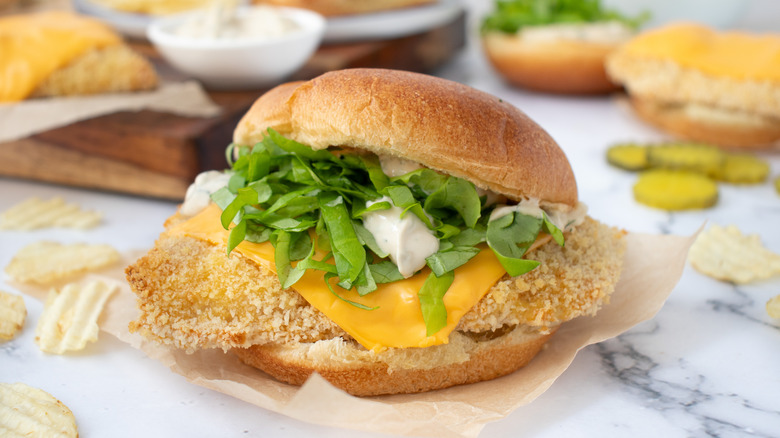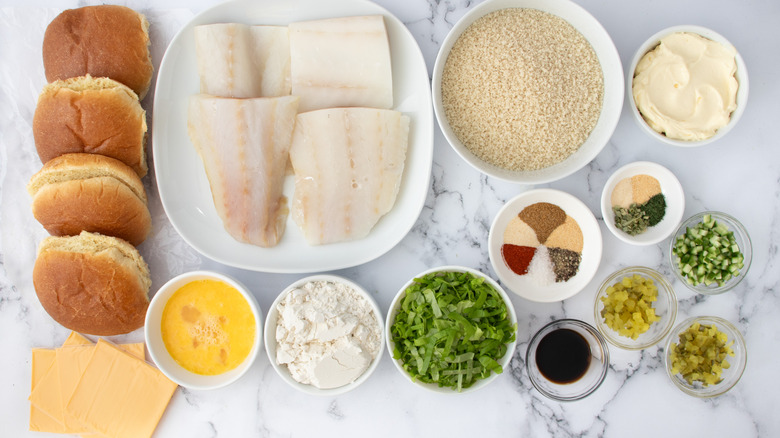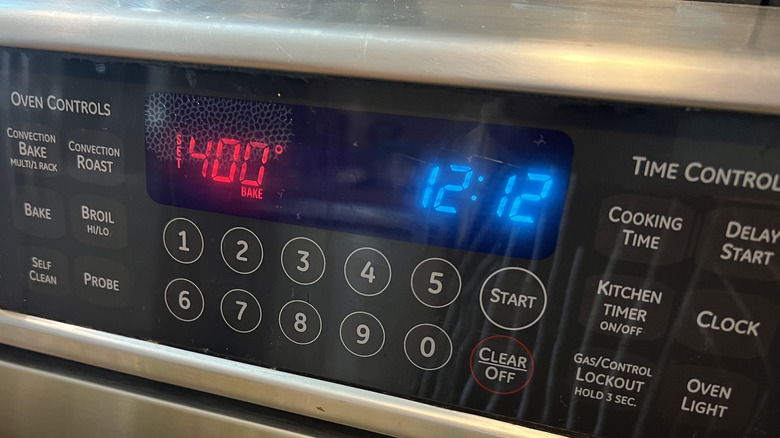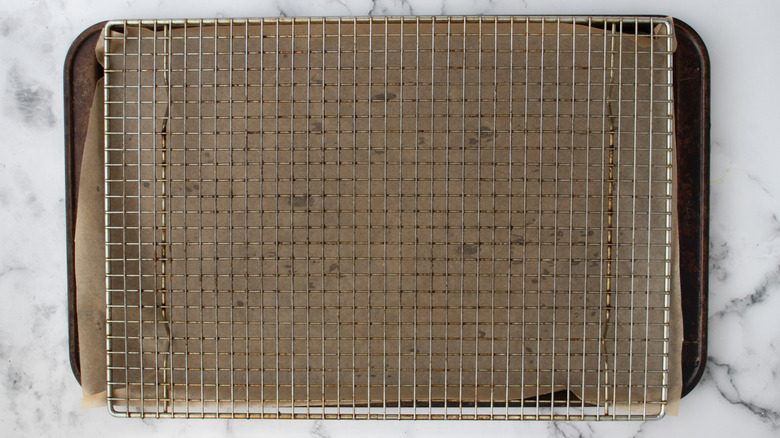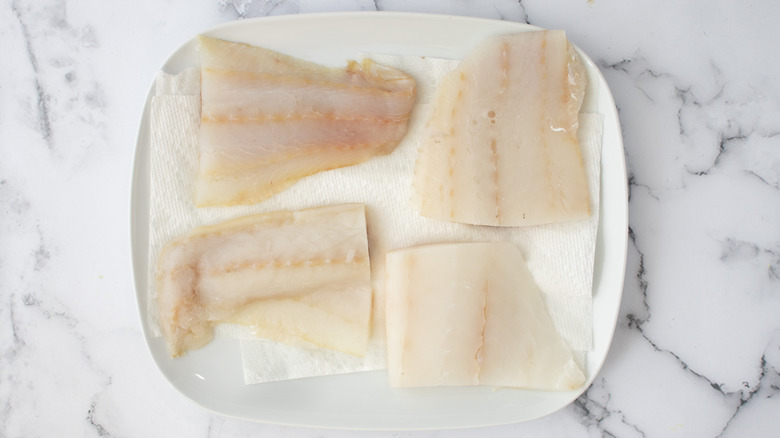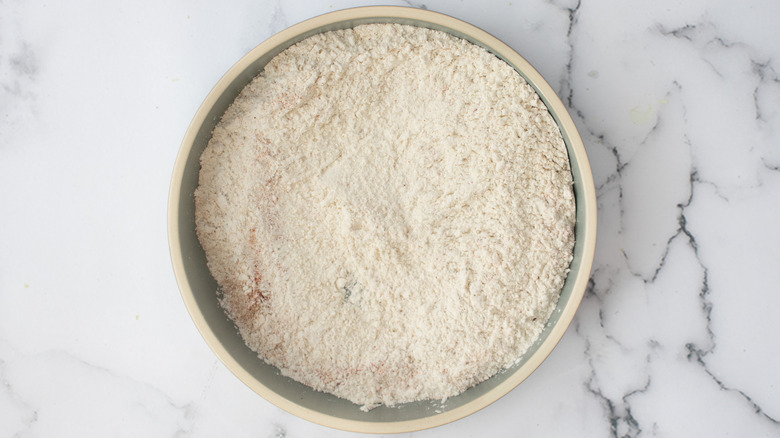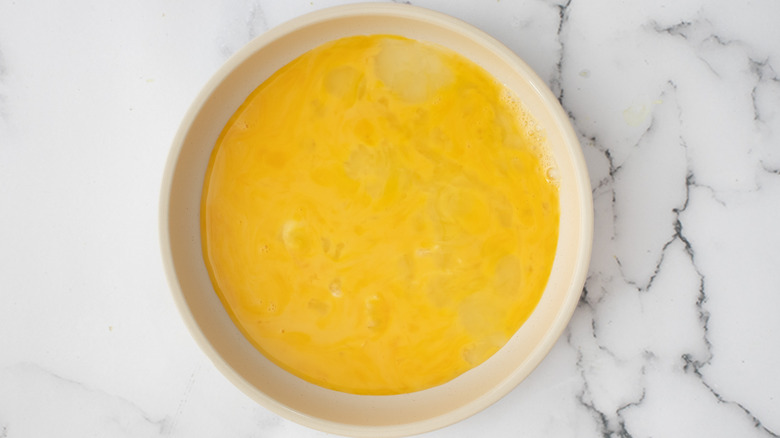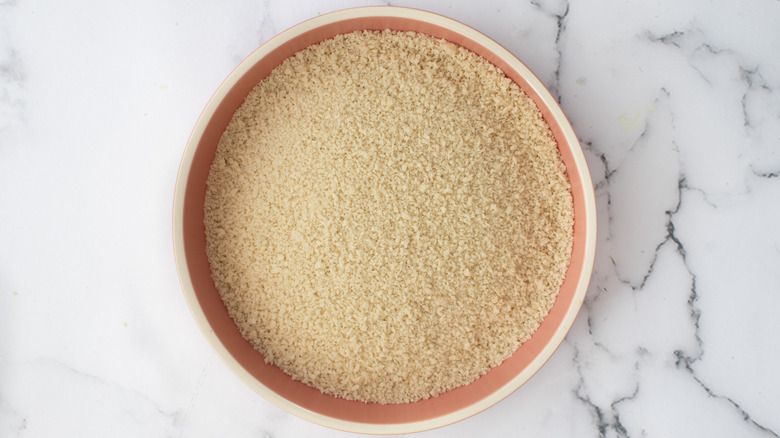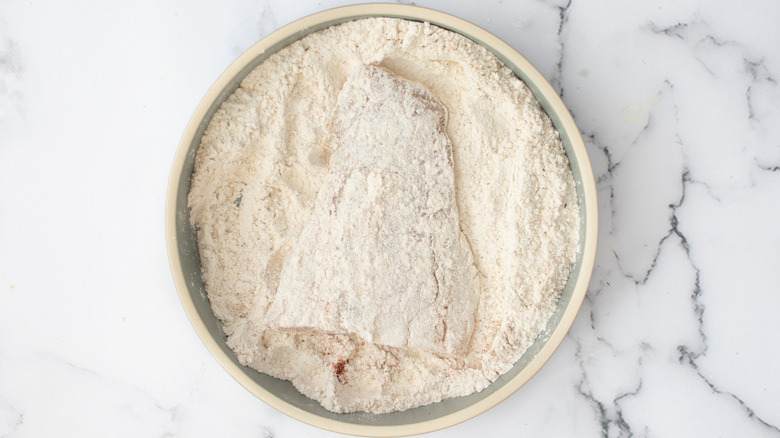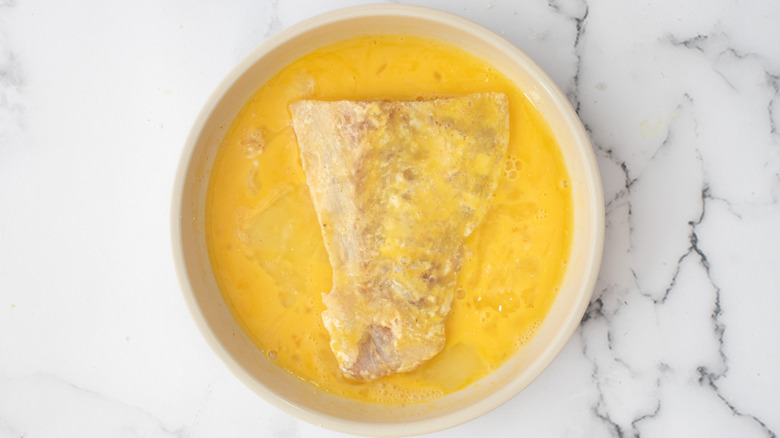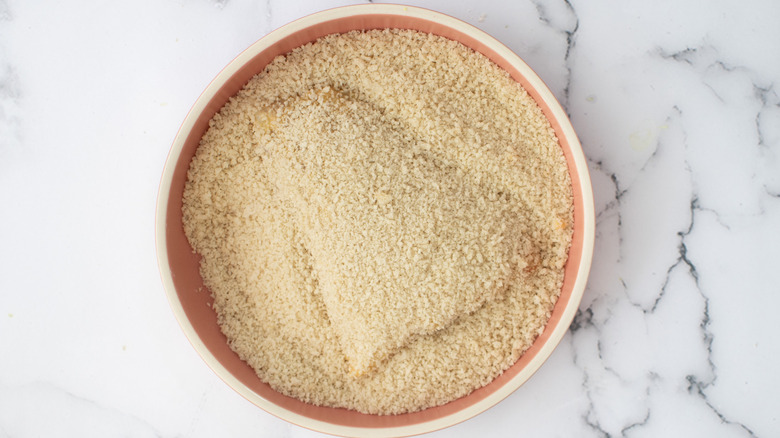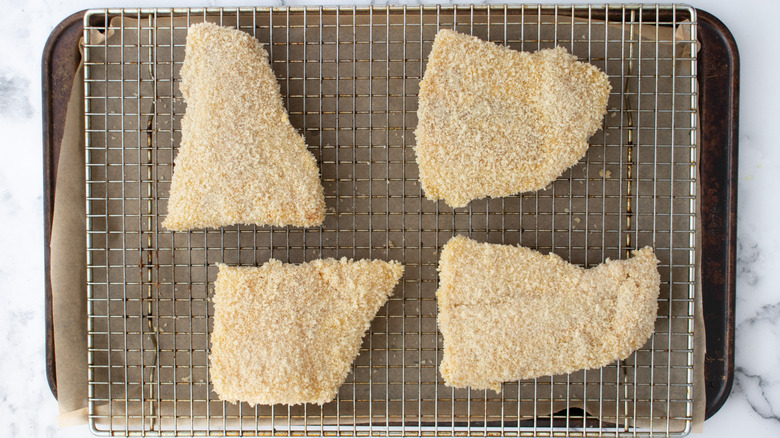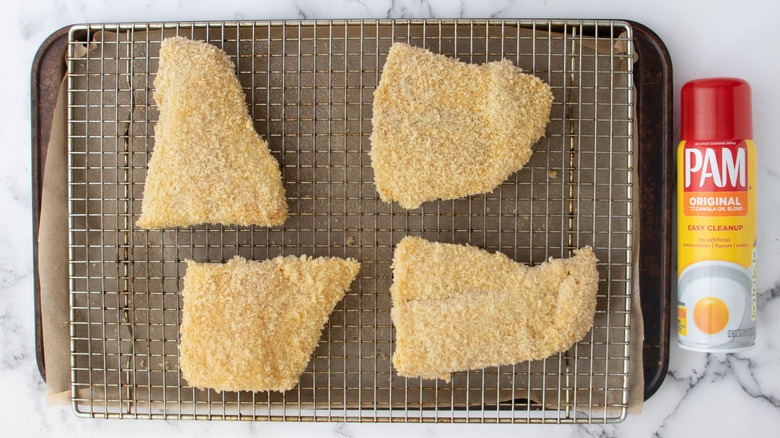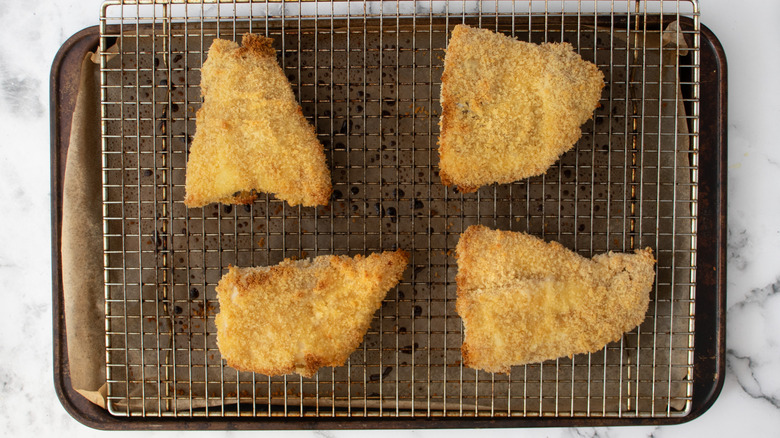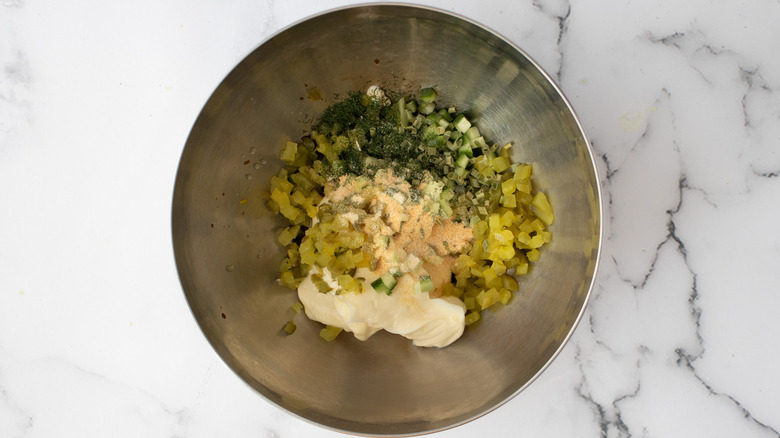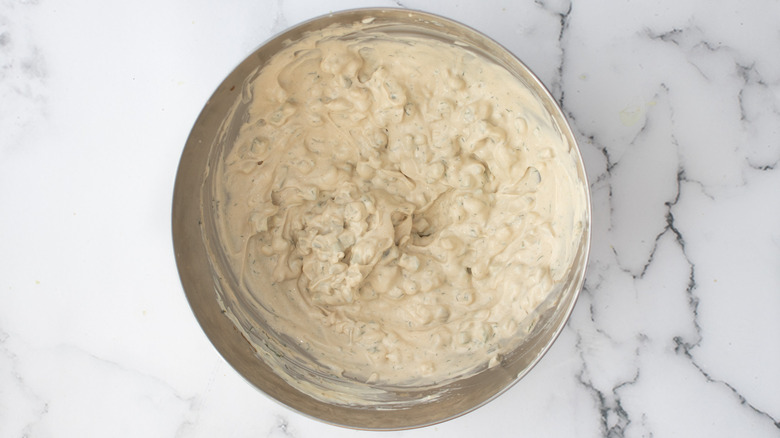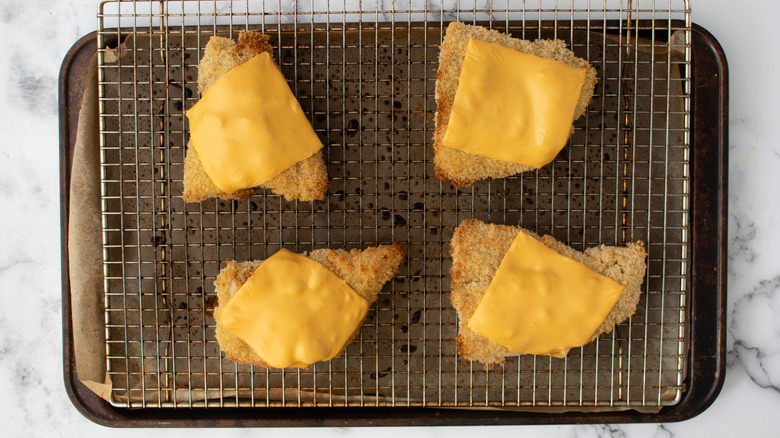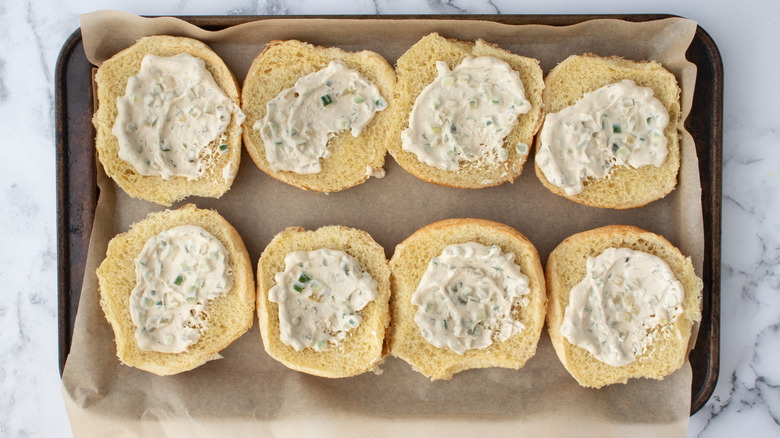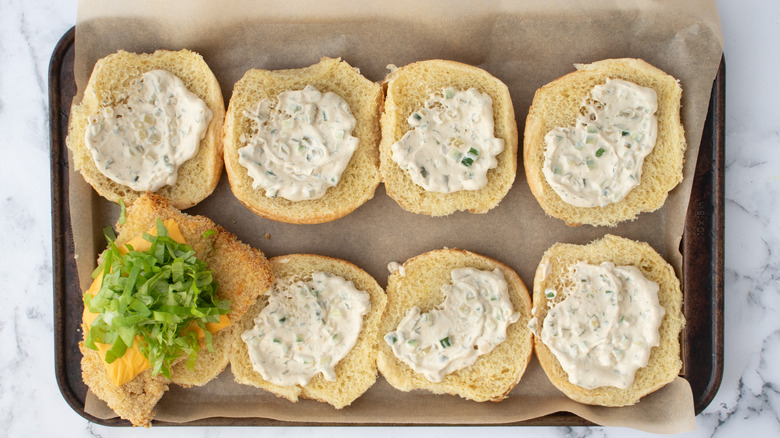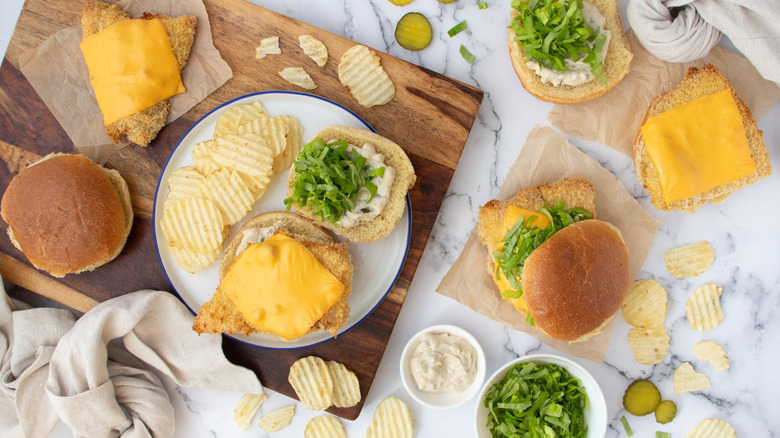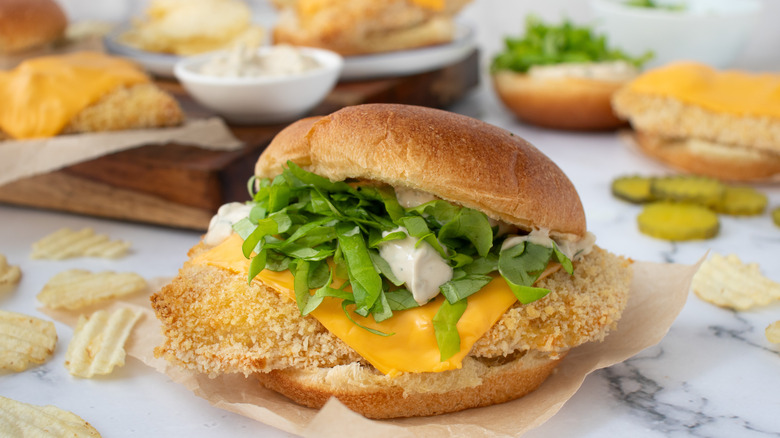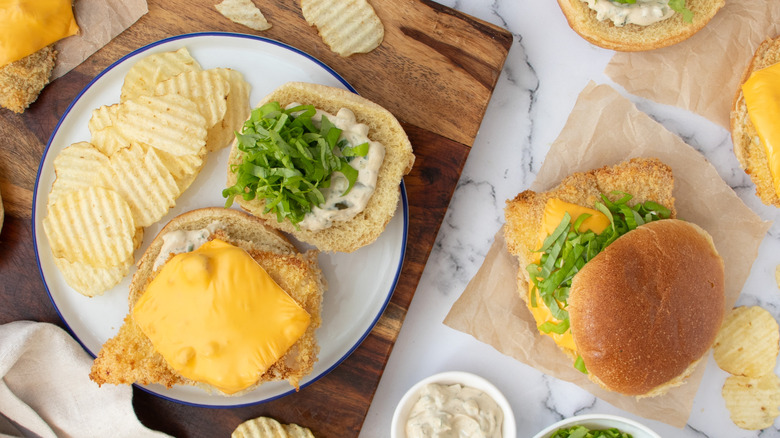Oven-Fried Fish Sandwich With Triple Pickle Tartar Recipe
Some dishes become associated with certain places or occasions, leaving you to think about them wistfully. Take fried fish sandwiches, often enjoyed in the peak of summer on the waterfront. If you're looking for delicious fish year-round, however, don't limit yourself to fast-food restaurant fish sandwiches. Mashed recipe developer Patterson Watkins shares this oven-fried fish sandwich with triple pickle tartar sauce sure to satisfy cravings. "It's all the things you love about a fast-food fish sandwich but way improved (better-for-you cooking method, better quality of seafood, and better, fresher ingredients)," she comments.
Watkins' recipe features an easy home cooking method eliminating deep fryers and hot oil, while still producing a tantalizing crispiness. "The combination of the crispity-crunchity coating and creamy, pickle-loaded tartar sauce make this one heck of a tasty sandwich," she raves. This triple pickle rendition features bread and butter pickles, dill pickles, and a quick cucumber pickle. Watkins explains, "Our third pickle actually occurs in the tartar sauce! Culinary magic (expecto pickle-tronum). Raw cucumber, combined with malt vinegar and herbs, makes for a quick pickle in the sauce." Have a surplus of pickles? Watkins says, "Feel free to flex on your favorite jarred pickle flavors here, substitutions allowed."
Follow Watkins' lead and serve this fish sandwich with "a good tater option ... either chips or fries, both set that classic 'fish and chips' scene," she says and adds, "If you are craving something healthier to pair, a nice vibrant side salad or vinegary slaw would work really well!"
Gather the ingredients for this oven-fried fish sandwich with triple pickle tartar
For this recipe, Watkins recommends using cod or haddock filets. "Cod is my all-time, go-to, preferred white fish! Cod filets are typically thicker and firmer, resulting in less breakage and, by design, present a lesser risk of drying out," she explains. "Haddock is my backup white fish," Watkins adds and describes, "Haddock filets tend to be thinner than cod, a little more fragile, but just as tasty — a good second-place contender."
The coating consists of all-purpose flour, Old Bay Seasoning (or seafood seasoning), garlic powder, onion powder, paprika, salt, black pepper, eggs (beaten), and panko breadcrumbs. For the tartar sauce, get mayonnaise, chopped dill pickle, chopped bread and butter pickle, chopped cucumber, garlic powder, onion powder, dried dill, dried chives, and malt vinegar. To assemble the sandwiches, you'll need American cheese slices, hamburger buns, and shredded lettuce.
Step 1: Preheat the oven
Preheat the oven to 400 F.
Step 2: Prep baking sheet
Line a large baking sheet with a wire rack and set aside.
Step 3: Dry the fish
Pat fish filets dry with paper towels.
Step 4: Combine the flour and seasonings
Place flour in a shallow bowl and season with Old Bay, garlic powder, onion powder, paprika, salt, and pepper. Stir to combine and set aside.
Step 5: Add the eggs to a bowl
Place eggs in another shallow bowl.
Step 6: Add the panko to a bowl
Place panko in a third shallow bowl.
Step 7: Dip fish in the flour
Working with one filet at a time, coat the fish in flour, shaking off any excess.
Step 8: Dip in the egg
Dip the fish in the egg, letting any excess drip off.
Step 9: Dip in the panko
Coat the fish in breadcrumbs, gently pressing to adhere crumbs to the filet.
Step 10: Place the fillets on sheet
Transfer coated fish to the prepared baking sheet and repeat the breading steps with the remaining filets.
Step 11: Oil the fish
Spritz the top of the coated filets with cooking spray and place in the oven.
Step 12: Bake the fish
Bake for 20 to 25 minutes or until crispy, golden brown, and cooked through.
Step 13: Prepare the sauce
Make the tartar sauce: Place mayonnaise, dill pickle, bread and butter pickle, cucumber, garlic powder, onion powder, dill, chives, and vinegar in a medium bowl. Whisk to combine.
Step 14: Chill the sauce
Cover and refrigerate until ready to assemble the sandwiches.
Step 15: Top fish with cheese
During the last 1 to 2 minutes of the fish baking, top each filet with a slice of cheese and return to the oven to melt.
Step 16: Spoon the sauce on buns
Divide tartar sauce between the buns, about a heaping tablespoon for each, and spread out in an even layer.
Step 17: Add the fish and lettuce
Top the bottom buns with the fish filets followed by shredded lettuce.
Step 18: Finish assembling and serve
Add the top bun and serve.
How should you store leftovers?
This crunchy, tangy sandwich features a few components, and you'll want to keep them separate to store any leftovers. Watkins notes, "You'll definitely get some shelf life mileage from this homemade tartar sauce, about five days-plus (longer if you substitute the fresh cucumber for another pickle), as long as the tartar sauce is covered in a sealable or wrapped container and refrigerated." You can even prep the tartar sauce in advance to make this sandwich even quicker to assemble. As for leftover sauce, Watkins says, "I would highly recommend serving with some crudité (excellent dip option) or as a blue cheese dressing substitute with Buffalo chicken. This sauce would also make for an excellent cheeseburger spread." You might just want to make extra in the first place!
The fish is a little more delicate to store and Watkins instructs, "If you cool the oven-fried fish at room temperature, then refrigerate it, loosely wrapped, you should be able to reheat and eat (in the oven, elevated on a wire rack) the next day." You'll want to eat it soon though, as she notes, "Fresh fish, even freshly cooked fish, doesn't have the longest shelf life, only three days. And, around day two, the panko coating will definitely start to get soggy." To avoid disappointment she says, "I recommend oven-frying your sandwiches in batches if you're making less than four or if you may have a gap in time when you'll be enjoying these leftovers."
What are the benefits of oven-frying the fish?
There's nothing quite like the crunchy crispness of fried foods, but regularly making them at home is messy and not that healthy — a technique much better left to restaurant kitchen professionals. Thankfully, alternative cooking methods can bring everything you love about deep-frying with less of what you don't. Although Watkins still deep fries some foods at home, she notes, "There are two reasons why I occasionally prefer oven-frying to deep frying."
The first comes down to the food's consistency: "It is a lot less greasy and, by default, much healthier," she explains. In that same greasy vein she says, "As much as I love a good deep fry, I do not love cleaning up after a deep-fry session." Aside from having to clean up the oil spatters, she points out that "Having to dispose of fryer oil is a bit of a pain." Keep it simple and use the contained space in your oven for similarly crispy results.
Oven-Fried Fish Sandwich with Triple Pickle Tartar Recipe
You can recreate the iconic fast-food fish sandwich at home, but without the mess of frying. This pickle-lovers version is also much fresher and healthier.
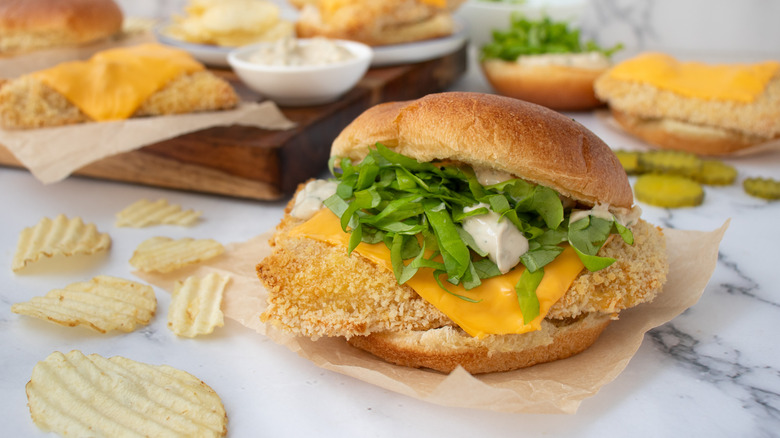
Ingredients
- 4 cod or haddock filets
- 1 cup all-purpose flour
- 1 teaspoon Old Bay Seasoning or seafood seasoning
- ½ teaspoon garlic powder
- ½ teaspoon onion powder
- ½ teaspoon paprika
- ½ teaspoon salt
- ½ teaspoon black pepper
- 2 eggs, beaten
- 2 cups panko breadcrumbs
- For the triple pickle tartar sauce
- ¾ cup mayonnaise
- 2 tablespoons chopped dill pickle
- 2 tablespoons chopped bread and butter pickle
- ¼ cup chopped cucumber
- ½ teaspoon garlic powder
- ½ teaspoon onion powder
- ½ teaspoon dried dill
- 1 teaspoon dried chives
- 1 tablespoon malt vinegar
- 4 slices American cheese
- 4 hamburger buns
- 2 cups shredded lettuce
Directions
- Preheat the oven to 400 F.
- Line a large baking sheet with a wire rack and set aside.
- Pat fish filets dry with paper towels.
- Place flour in a shallow bowl and season with Old Bay, garlic powder, onion powder, paprika, salt, and pepper. Stir to combine and set aside.
- Place eggs in another shallow bowl.
- Place panko in a third shallow bowl.
- Working with one filet at a time, coat the fish in flour, shaking off any excess.
- Dip the fish in the egg, letting any excess drip off.
- Coat the fish in breadcrumbs, gently pressing to adhere crumbs to the filet.
- Transfer coated fish to the prepared baking sheet and repeat the breading steps with the remaining filets.
- Spritz the top of the coated filets with cooking spray and place in the oven.
- Bake for 20 to 25 minutes or until crispy, golden brown, and cooked through.
- Make the tartar sauce: Place mayonnaise, dill pickle, bread and butter pickle, cucumber, garlic powder, onion powder, dill, chives, and vinegar in a medium bowl. Whisk to combine. Cover and refrigerate until ready to assemble the sandwiches.
- During the last 1 to 2 minutes of the fish baking, top each filet with a slice of cheese and return to the oven to melt.
- Divide tartar sauce between the buns, about a heaping tablespoon for each, and spread out in an even layer.
- Top the bottom buns with the fish filets followed by shredded lettuce.
- Add the top bun and serve.
Nutrition
| Calories per Serving | 258 |
| Total Fat | 12.7 g |
| Saturated Fat | 2.7 g |
| Trans Fat | 0.0 g |
| Cholesterol | 61.3 mg |
| Total Carbohydrates | 20.7 g |
| Dietary Fiber | 1.0 g |
| Total Sugars | 1.6 g |
| Sodium | 348.7 mg |
| Protein | 14.1 g |
